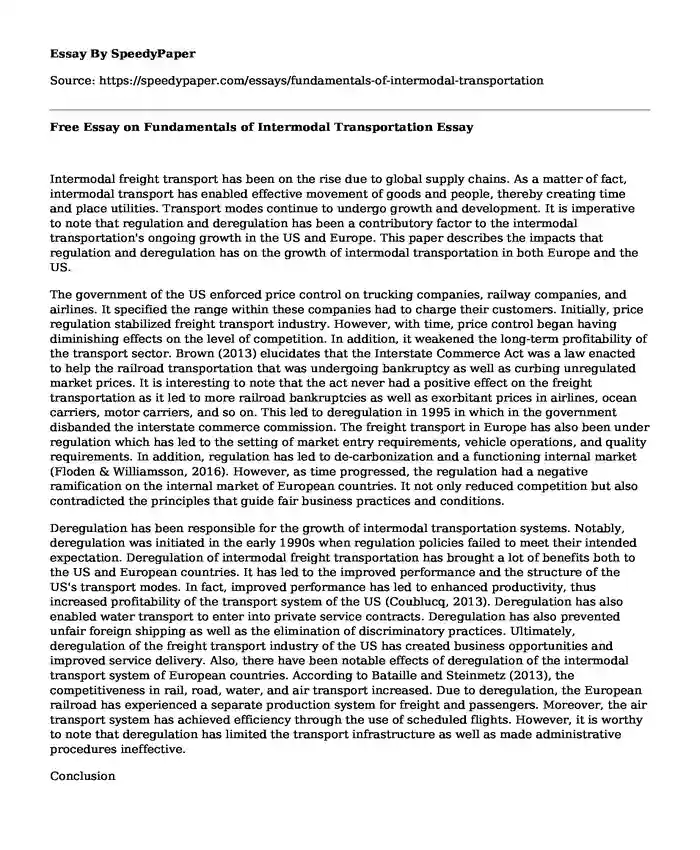Intermodal freight transport has been on the rise due to global supply chains. As a matter of fact, intermodal transport has enabled effective movement of goods and people, thereby creating time and place utilities. Transport modes continue to undergo growth and development. It is imperative to note that regulation and deregulation has been a contributory factor to the intermodal transportation's ongoing growth in the US and Europe. This paper describes the impacts that regulation and deregulation has on the growth of intermodal transportation in both Europe and the US.
The government of the US enforced price control on trucking companies, railway companies, and airlines. It specified the range within these companies had to charge their customers. Initially, price regulation stabilized freight transport industry. However, with time, price control began having diminishing effects on the level of competition. In addition, it weakened the long-term profitability of the transport sector. Brown (2013) elucidates that the Interstate Commerce Act was a law enacted to help the railroad transportation that was undergoing bankruptcy as well as curbing unregulated market prices. It is interesting to note that the act never had a positive effect on the freight transportation as it led to more railroad bankruptcies as well as exorbitant prices in airlines, ocean carriers, motor carriers, and so on. This led to deregulation in 1995 in which in the government disbanded the interstate commerce commission. The freight transport in Europe has also been under regulation which has led to the setting of market entry requirements, vehicle operations, and quality requirements. In addition, regulation has led to de-carbonization and a functioning internal market (Floden & Williamsson, 2016). However, as time progressed, the regulation had a negative ramification on the internal market of European countries. It not only reduced competition but also contradicted the principles that guide fair business practices and conditions.
Deregulation has been responsible for the growth of intermodal transportation systems. Notably, deregulation was initiated in the early 1990s when regulation policies failed to meet their intended expectation. Deregulation of intermodal freight transportation has brought a lot of benefits both to the US and European countries. It has led to the improved performance and the structure of the US's transport modes. In fact, improved performance has led to enhanced productivity, thus increased profitability of the transport system of the US (Coublucq, 2013). Deregulation has also enabled water transport to enter into private service contracts. Deregulation has also prevented unfair foreign shipping as well as the elimination of discriminatory practices. Ultimately, deregulation of the freight transport industry of the US has created business opportunities and improved service delivery. Also, there have been notable effects of deregulation of the intermodal transport system of European countries. According to Bataille and Steinmetz (2013), the competitiveness in rail, road, water, and air transport increased. Due to deregulation, the European railroad has experienced a separate production system for freight and passengers. Moreover, the air transport system has achieved efficiency through the use of scheduled flights. However, it is worthy to note that deregulation has limited the transport infrastructure as well as made administrative procedures ineffective.
Conclusion
The idea of regulating the intermodal transport in both the US and European was to establish a functioning internal market, encourage fair competition, and encourage de-carbonization. However, regulation brought several challenges such as the increased cost of transport, lack of competition, and so on. The ramification for these problems was concerted efforts to deregulate intermodal freight transportation. Actually, deregulation solved some of the problems of regulation by increasing competition, productivity, and profitability of intermodal transportation. Nonetheless, deregulation has shortcomings such as ineffective administrative procedures.
References
Bataille, M., & Steinmetz, A. (2013). Intermodal competition on some routes in transportation networks: The case of inter-urban buses and railways (No. 84). DICE Discussion Paper.
Brown, J. H. (2013). The 'Railroad Problem' and the interstate commerce act. Review of Industrial Organization, 43(1-2), 7-19.
Coublucq, D. (2013). Econometric Analysis of Productivity with Measurement Error: Empirical Application to the US Railroad Industry (No. 95). DICE Discussion Paper.
Floden, J., & Williamsson, J. (2016). Business models for sustainable biofuel transport: the potential for intermodal transport. Journal of Cleaner Production, 113, 426-437.
Cite this page
Free Essay on Fundamentals of Intermodal Transportation. (2022, Jun 06). Retrieved from https://speedypaper.net/essays/fundamentals-of-intermodal-transportation
Request Removal
If you are the original author of this essay and no longer wish to have it published on the SpeedyPaper website, please click below to request its removal:
- Settlement Patterns, Free Essay in American History
- Free Essay on Get a Franchise of Chick A Filet
- Free Essay on Concept and Models of Mental Health
- Digital Broadcasting Essay Sample
- Articles Analysis Essay Sample on Obesity
- Free Essay Example on the Problem of Evil and Suffering
- The Iron Lady With a Big Heart. Paper Example
Popular categories





